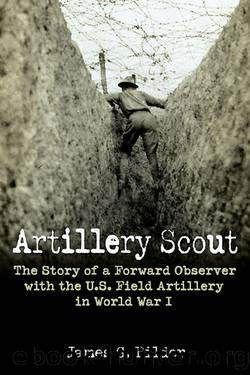Artillery Scout by James G. Bilder

Author:James G. Bilder
Language: eng
Format: epub
Publisher: Casemate Publishers (Ignition)
Published: 2014-03-15T00:00:00+00:00
CHAPTER 6
St. Mihiel: The Americans Enter the War in Earnest
FRENCH GENERAL FERDINAND Foch, the Supreme Commander of Allied forces in France, had proposed in July of 1918 a strategy to drive the Germans out of France, back to the Hindenburg Line along their own border, and into capitulation before yearâs end. The addition of American personnel and money now gave him almost limitless resources to conduct war against a foe rapidly fading out of existence. Under Fochâs plan, the Germans would become the anvil forced to absorb relentless blows from the Allied hammer.
Foch believed that the destruction of the German salients at Amiens (Australian, Canadian, British, Frenchâand a small Americanâsector), the Marne (French & American sector), and St. Mihiel (also French and American sector) would form a solid and easily maneuverable Allied line from which he could then deliver the death blow to what remained of the German Army and win the war for the Allies. The plan has been recorded in history as the â100 Days Campaign,â as well as âThe Grand Offensive.â
The strategy obviously was working. The Allied counter-offensive began at the Second Battle of the Marne (Soissons to the Americans) in mid-July and then progressed to the north at Amiens on August 8th. Amiens met with quick success, as 16,000 enemy troops surrendered almost immediately in what German Commander Erich Ludendorff referred to as âthe Black Day of the German Army.â
Len and everyone else knew on September 11th that they were on the eve of another âbig push.â It could be felt as much as the cold and rain that permeated everything. The men were ordered to check their personal equipment as the gun crews made their final preparations.
Len and the others were given their gas masks. They were not issued the British canister style to which they were accustomed, but rather the French Tissot models. The French masks had the innovative design of air valves under the eyepieces so that the lens would not fog over. Gloves (âoilcloth mittsâ) were dispensed as well. It was very frightening; every man knew this was for protection from mustard gas (âyellow crossâ) that the Germans now used with great frequency.
Len and his companions had been exposed to tear gas in training, but mustard gas was unknown amongst their experiences and the unknown is always the most frightening. The personal weapons, for Len a trench knife and .45 caliber colt sidearm, were checked. He wouldnât be taking a rifle or Annabel for this action. For one, poor Annabel would sink in the water-filled mud holes and drown. The mud swallowed men and animals faster than quicksand, and for another, heâd be repositioned in a dugout before the fight began.
Germans wearing American uniforms in order to cause additional chaos and confusion on the battlefield was not a tactic that originated with the Ardennes (Bulge) Offensive of World War II. English speaking Germans had been reported wearing the uniforms of captured American officers and, during the high point of battle, running up and down U.
Download
This site does not store any files on its server. We only index and link to content provided by other sites. Please contact the content providers to delete copyright contents if any and email us, we'll remove relevant links or contents immediately.
| Afghan & Iraq Wars | American Civil War |
| American Revolution | Vietnam War |
| World War I | World War II |
Waking Up in Heaven: A True Story of Brokenness, Heaven, and Life Again by McVea Crystal & Tresniowski Alex(37019)
Empire of the Sikhs by Patwant Singh(22185)
We're Going to Need More Wine by Gabrielle Union(18086)
Hans Sturm: A Soldier's Odyssey on the Eastern Front by Gordon Williamson(16788)
Leonardo da Vinci by Walter Isaacson(11919)
The Radium Girls by Kate Moore(10916)
Educated by Tara Westover(7078)
Tools of Titans by Timothy Ferriss(6965)
How to Be a Bawse: A Guide to Conquering Life by Lilly Singh(6701)
The Last Black Unicorn by Tiffany Haddish(5081)
Permanent Record by Edward Snowden(5007)
The Rise and Fall of Senator Joe McCarthy by James Cross Giblin(4852)
Promise Me, Dad by Joe Biden(4457)
The Wind in My Hair by Masih Alinejad(4427)
The Crown by Robert Lacey(4115)
A Higher Loyalty: Truth, Lies, and Leadership by James Comey(4041)
The Iron Duke by The Iron Duke(3651)
Joan of Arc by Mary Gordon(3270)
How to be Champion: My Autobiography by Sarah Millican(3194)
